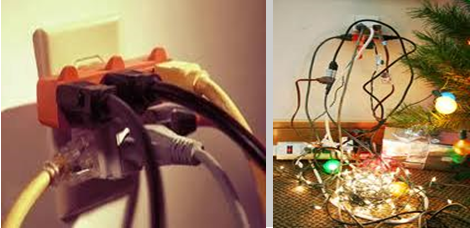What happens when you plug in a toaster and a microwave on the same circuit and try to run them at the same time? The circuit breaker will trip thank god it’s doing its job.
The problem? An overloaded circuit. The power needed to run both appliances is not enough for one breaker.
The breaker is there to protect the wire that is running from it to your outlet or light. The microwave can draw up to 1400 watts and the toaster can draw up to 1200 watts. 1400 plus 1200 is 2600 watts divided by the voltage 120 equals about 21 amps. The little number on your circuit breaker is expressed in amps. Most circuit breakers are rated for 15 amps so you can see that 21 amps is way over the threshold of what the breaker can handle.
So why not just replace the 15 amp breaker with a higher rated breaker. Well, the breaker is trying to protect the wiring. If you place a higher rated breaker in place of the 15 amp breaker the breaker will be saying as both the microwave and toaster appliances are running at the same time to bring it on because I won’t trip now. I can handle your wattage and load now. But the wiring from the breaker to the outlet will be screaming and melting because it was only rated to work with a max of 15 amps as my load with the original breaker.
To avoid this problem we would run what is called dedicated circuits from a new higher rated breaker with heavier gauged wires to the appliances with the heavy wattage loads.
Common Dedicated Circuits
- Appliance Power 1,200 watts and up
- Electric Range 5,000 watts (240 volts)
- Electric Dryer 6,000 watts (240 volts)
- Space Heater 1,000 watts and up
- Clothes Washer 1,200 watts
- Furnace (blower) 1,200 watts
- Microwave 700–1,400 watts
- Refrigerator 800 watts
- Freezer (not required) 700
- Dishwasher 1,400 watts
- Central Vacuum 1,000 watts
- Whirlpool/Jacuzzi 1,000 watts and up
- Garbage Disposal 600–1,200 watts
- Kitchen Countertop (two circuits):
- Toaster 1,200 watts
- Coffee maker 1,000 watts
- Toaster oven 1,400 watts
- Bathroom:
- Hair dryer up to 1,800 watts
Practical advice: Don’t load your circuits to the maximum (figure about 70-80 percent of what the breaker is rated for). Otherwise, you’re more likely to have hassles with overloads when you temporarily plug in high-draw devices such as a vacuum cleaner (800 to 1,100 watts).
Call Richard Marton Electrical Contractor LLC and he can answer all your questions about overloaded circuits, electrical panels, breakers, fuses, dedicated circuits, electrical loads and more.
Call Now! 201-262-7710
Richard Marton Electrical Contractor LLC is a full service electrical contractor serving homeowners and businesses in Bergen, Passaic, Essex and Morris County New Jersey with electrical installations and repairs. We are also a certified Generac Generator dealer and installer.
Richard Marton Electrical Contractor LLC works with general contractors, residential architects, interior decorators, interior designers, painters, property management and property maintenance professionals, and professional organizers. We work with these professionals to give clients top of the line electrical installations within such projects as residential remodeling, residential renovations, plus build outs of new kitchens, bathrooms, home offices, add-a-level residential project and more.

